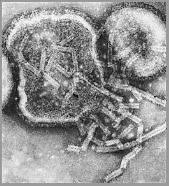PARAINFLUENZA 2
"Although there is no prevention against acquiring me, you can Rubula-t of Vicks VapoRub on your chest and see if thatíll cure ya."
DESCRIPTION Parainfluenza viruses belong to the Paramyxovidridae viral family and they
have a medium-sized virion particlea, are enveloped, nonsegmented, and their
genome is composed of a negative-strand RNA. This serotype of parainfluenza
belongs to the genus Rubulavirus. This virus is a common human respiratory pathogen. There are four human
parainfluenza viruses and they were first discovered during 1956 to 1960.
Parainfluenza 2 was recognized by its cytopathic effects, which were seen in
infected tissue culture and the virus was isolated from infants and children
with lower respiratory tract disease. POWER
OFFENSES
ATTACKS
Transmission of the virus is direct contact between persons through respiratory secretions or by large droplet spread. The virus does not thrive long in the environment.
It has been proven that by the age of 5 years old, 60% will have had this type of parainfluenza.
OUTCOME
Initial symptoms include cough and hoarseness. Fever is also present, with the temperature usually above 100 degrees F, and it lasts around 2 to 3 days. Signs that are present consist of rhinitis, coarse breath sounds, erythema of the pharyngeal mucous membranes, and rhonchi. The most common type of illness that has been observed in children incorporate pharyngitis, bronchitis, and rhinitis, these usually being accompanied by fever. It is possible for pneumonia or bronchiolitis to develop as well.
Type 2 of parainfluenza is the most common cause of croup (laryngotracheobronchitis). The symptoms of this include cough, fever, and respiratory distress.
A serious cytopathic effect (CPE) caused by type 2 is the induction of synctia.
SPEED
Parainfluenza viruses multiply slowly.Because there is such a high frequency of reinfection, it is believed that this virus spreads readily from person to person. The incubation period is speculated to be about 2 to 6 days, although it remains unknown in pediatric infections. Shedding of the virus is maintained continues for a week after this.
Type 2 is known to cause epidemics for 2 year intervals. It is termed an autumn epidemic.
DEFENSES
VACCINES
Inactivated parainfluenza virus vaccines have been developed for this serotype. It was observed as antigenic in children, yet parenteral administration did not produce resistance to the disease.
At this time, the development of an intranasal vaccine is undergoing progress.
BEHAVIORAL
It has been recommended that pediatric patients be cared for in wards, namely those with barriers so as not to infect others.
TREATMENT
The treatment for the symptoms of croup include large doses of corticosteroids in order to shorten the incubation period. Also, humidification by air and inhalation of epinephrine are of aid. The only anti-viral drug that has shown to be somewhat helpful is ribavirin. Otherwise, no specific treatment is available.
GAME ACTION
Your child develops a serious case of croup. What sort of treatment will you provide for your sick child? Be specific, give brand names.